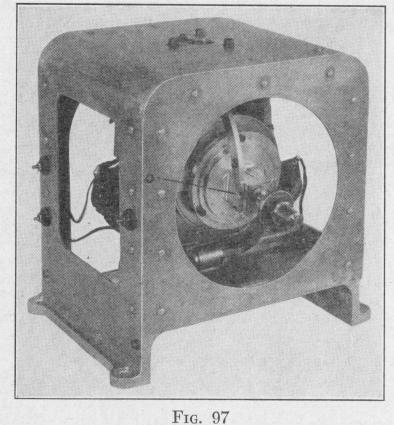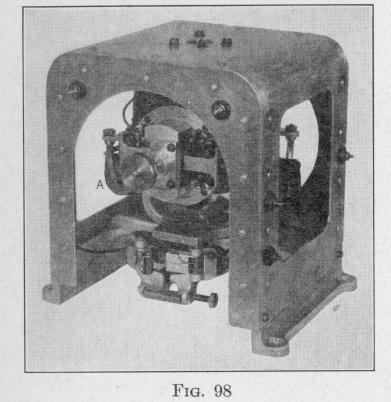124 THE GYROSCOPIC PENDULUM
electric system of the airplane, while the power to operate the rudders is supplied by air turbines which rotate when the airplane is in motion.
The directional gyro, that is the gyro which by operating vertical rudders keeps the machine on its straight course, is shown in Figs. 97 and 98. If the airplane turns in azimuth, the gyro-frame turns relative to the spin-axle; two contactor plates attached to the frame slide along a trolley not shown in the figures; an electrically operated clutch connects one of the air turbines to the vertical rudder thereby automatically turning the airplane back into the course.
The frictional forces acting at the bearings of the gyro are so small that the spin-axle will remain fixed in space for several minutes, but after a time the spin-axle will be appreciably out of its original direction. So long as the airplane is on a straight course the degree of constancy in direction of the spin-axle can be checked by comparison with a spirit level and magnetic compass. When the spin-axle does become tilted from the horizontal, an air-blast escaping from an orifice in the gyro-casing 0, Fig. 97, produces a torque about a vertical axis, which torque automatically brings the spin-axle back into a horizontal plane. When the spin-axle is horizontal, the orifice is covered by a shutter S and the abovedescribed torque is not produced.
When the aviator observes that the snip-axle has moved in
GYRO-HORIZONTALS AND GYRO-VERTICALS 125
azimuth from the original setting, he presses an electric button, thereby energizing one of a pair of curved solenoids A, A', Fig. 98, attached to the gyro-frame. This causes a curved iron core attached to the gyro-casing to be pulled toward the middle of the solenoid, thereby developing a torque on the casing, about a horizontal axis, in the proper direction to cause the spin-axle to precess about a vertical axis back into the original direction. This operation moves the contactor attached to the gyro-casing, relative to the trolley, thereby causing one of the air turbines to turn a vertical rudder in the proper direction to bring the keel of
the airplane parallel to the new position of the spin-axle, that is, to bring it into the original course.
There are two electric buttons, curved solenoids and curved cores, one system to cause a turning of the airplane in the clockwise direction and another to cause a turning in the counter-clockwise direction.
The second gyro operates in a manner similar to the directional gyro, above described, except that this gyro with vertical spinaxle operates horizontal rudders so as to maintain the axis of the airplane in a horizontal position.
79. The Sperry-Carter Track Recorder. - This is a group of instruments* that while carried on a test car moving at train speed
* Railway Engineering and Maintenance. Vol. 23. D. 316

